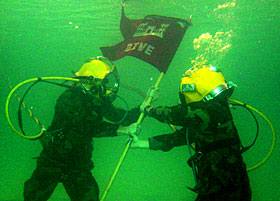UNDERWATER COMMAND CHANGE
Apropos of nothing in particular:

U.S. Army photo by Sgt. Mark Claudio
DefenseLINK : Army Lt. Col. Jeffrey Helmick, left, commander of the 6th Transportation Battalion, 7th Transportation Group, hands the company guidon to Capt. Clayton Lull during the U.S. Army Dive Company underwater change of command ceremony Jan. 27 at Fort Eustis, Va. The company is the only unit of its kind in the Army, and its soldiers perform a variety of sub-aquatic missions. Many of them are currently deployed in support of Operation Iraqi Freedom.




Living near the Rock Island Arsenal, I’m used to these command change ceremonys, but NEVER underwater!
It does look like they’re in over their heads. *groan*
That’s deep.
I am confused…most of the command changes I went through in the Army had the outgoing commander give the guidearm to the Senior Enlisted (usually SGM) and he would give it to the new commander. Where is the SGM…of course sense SGM walk on water it would be difficult
Likely the CSM’s in a boat above them in order to rescue the guidon in the event that someone does the butterfingers bit. Yeah, that’s the ticket…
The tradition in today’s Army is for the senior enlisted soldier — 1SG or CSM — to command the formation of troops for the ceremony. The guidon bearer gives the guidon to the 1SG/CSM, who then passes it to the outgoing commander as a symbol of thanks for his/her tenure as commander. The outgoing commander then passes it to his commander, symbolizing the relinquishment of command. The reviewing officer than passes the flag to the incoming commander, symbolizing the taking of command by the new officer. The incoming commander then passes the guidon back to the 1SG/CSM, representing the commander’s reposing of trust in this NCO for the welfare of the unit and its troops. Then the officers walk off the field, or in this case, swim to the surface.
(And yes, I’ve written a few of these scripts so I’ve memorized the symbolism behind each act)
Phil, is there any danger of that turning into an infinite loop?
—